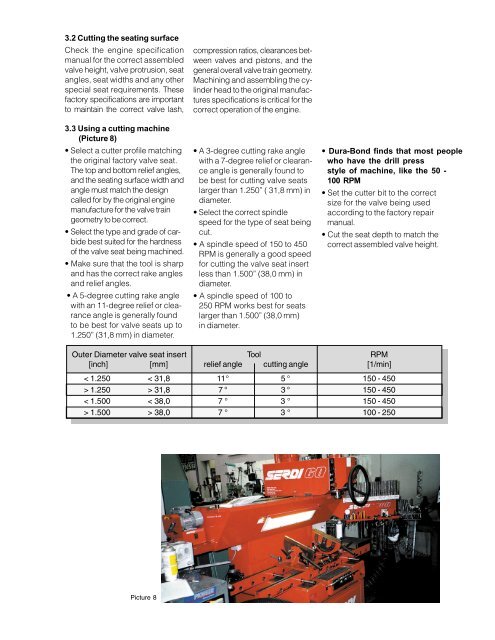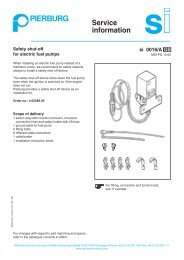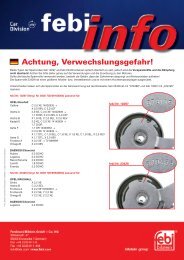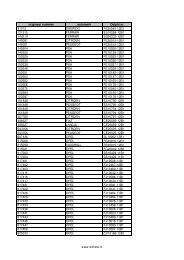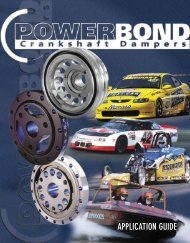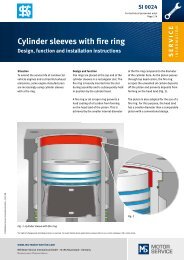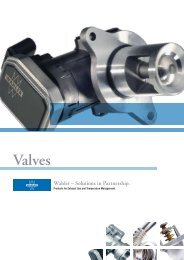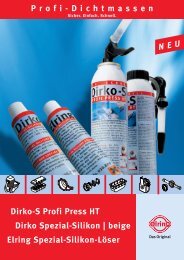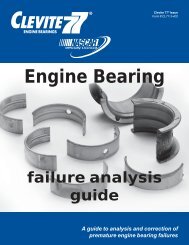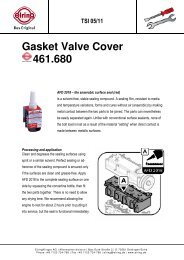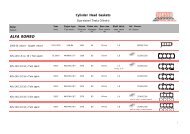Dura-Bond Valve Seat Inserts Info. - Dura-Bond Bearing
Dura-Bond Valve Seat Inserts Info. - Dura-Bond Bearing
Dura-Bond Valve Seat Inserts Info. - Dura-Bond Bearing
- No tags were found...
You also want an ePaper? Increase the reach of your titles
YUMPU automatically turns print PDFs into web optimized ePapers that Google loves.
3.2 Cutting the seating surface<br />
Check the engine specification<br />
manual for the correct assembled<br />
valve height, valve protrusion, seat<br />
angles, seat widths and any other<br />
special seat requirements. These<br />
factory specifications are important<br />
to maintain the correct valve lash,<br />
3.3 Using a cutting machine<br />
(Picture 8)<br />
• Select a cutter profile matching<br />
the original factory valve seat.<br />
The top and bottom relief angles,<br />
and the seating surface width and<br />
angle must match the design<br />
called for by the original engine<br />
manufacture for the valve train<br />
geometry to be correct.<br />
• Select the type and grade of carbide<br />
best suited for the hardness<br />
of the valve seat being machined.<br />
• Make sure that the tool is sharp<br />
and has the correct rake angles<br />
and relief angles.<br />
• A 5-degree cutting rake angle<br />
with an 11-degree relief or clearance<br />
angle is generally found<br />
to be best for valve seats up to<br />
1.250” (31,8 mm) in diameter.<br />
compression ratios, clearances between<br />
valves and pistons, and the<br />
general overall valve train geometry.<br />
Machining and assembling the cylinder<br />
head to the original manufactures<br />
specifications is critical for the<br />
correct operation of the engine.<br />
• A 3-degree cutting rake angle<br />
with a 7-degree relief or clearance<br />
angle is generally found to<br />
be best for cutting valve seats<br />
larger than 1.250” ( 31,8 mm) in<br />
diameter.<br />
• Select the correct spindle<br />
speed for the type of seat being<br />
cut.<br />
• A spindle speed of 150 to 450<br />
RPM is generally a good speed<br />
for cutting the valve seat insert<br />
less than 1.500” (38,0 mm) in<br />
diameter.<br />
• A spindle speed of 100 to<br />
250 RPM works best for seats<br />
larger than 1.500” (38,0 mm)<br />
in diameter.<br />
• <strong>Dura</strong>-<strong>Bond</strong> finds that most people<br />
who have the drill press<br />
style of machine, like the 50 -<br />
100 RPM<br />
• Set the cutter bit to the correct<br />
size for the valve being used<br />
according to the factory repair<br />
manual.<br />
• Cut the seat depth to match the<br />
correct assembled valve height.<br />
Outer Diameter valve seat insert Tool RPM<br />
[inch] [mm] relief angle cutting angle [1/min]<br />
< 1.250 < 31,8 11° 5 ° 150 - 450<br />
> 1.250 > 31,8 7 ° 3 ° 150 - 450<br />
< 1.500 < 38,0 7 ° 3 ° 150 - 450<br />
> 1.500 > 38,0 7 ° 3 ° 100 - 250<br />
8<br />
Picture 8


